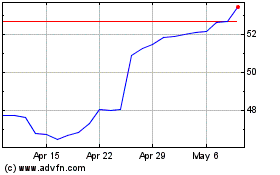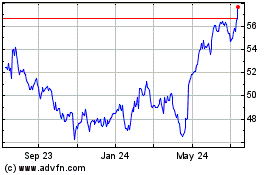By Saabira Chaudhuri
LONDON-- Unilever PLC has replaced the head of its flagging
margarine business, raising questions about the unit's future at
the world's No. 2 consumer-goods giant.
Margarine isn't just any business for the Procter & Gamble
Co. rival. Unilever was founded in 1929 through the merger of
British soap maker Lever Brothers and the Netherlands' Margarine
Unie, which began making the plant-derived spread in 1872. Today,
the company is the world's largest margarine maker, churning out
brands like Country Crock, Promise and Imperial.
But a sweeping shift in consumer tastes has hobbled Unilever's
efforts to turn the business around. Meanwhile, Chief Executive
Paul Polman has steered Unilever away from its slower-growing food
offerings and into higher-margin, faster-moving
home-and-personal-care products like mineral-oil-infused
moisturizers and $15 toothpaste.
Just over a year ago, Unilever announced it was hiving off its
U.S. and European margarine business into its own "baking, cooking
and spreads" unit that would allow it to manage its own costs and
make decisions independent of the rest of the company. Mr. Polman
put Sean Gogarty in charge, who had reported directly to him in the
past while marketing household cleaners. Mr. Polman introduced him
to analysts at the time as the company's "best marketer," according
to a person who attended one presentation.
Mr. Polman has likened separating out the margarine business to
putting a sick child in a separate room from siblings, and
showering extra care on them. But disclosing full-year earnings
Tuesday, Unilever said it wasn't "able to stem the sustained market
contraction in developed countries" in the margarine business. The
company has named Nicolas Liabeuf, formerly senior vice president
of marketing operations, to be Mr. Gogarty's replacement.
The Wall Street Journal first reported the management changes
early Tuesday.
A person familiar with Mr. Gogarty's departure said it was
motivated by incompatible views on how the spreads business should
be run. The disagreement came after Unilever's former boss of the
food business, Antoine de Saint-Affrique, left and was replaced by
Amanda Sourry in October. Unilever declined to comment.
On Tuesday, Exane BNP Paribas analyst Jeff Stent said Mr.
Gogarty leaving Unilever added to "inevitably increasing
speculation on an overall exit."
Unilever is working to boost margins for its home-care products,
strengthen its personal-care arm and cut costs across the company,
moves that analysts say reduce its dependence on the margarine
unit, which currently makes up 4% of sales. Margarine remains
highly profitable and has long been a cash cow for Unilever,
despite dragging down its food sales.
A big part of the problem for margarine is the revival of butter
after decades of being held up as the culprit for clogged arteries
and expanding waistlines.
Consumers have come to see it as more wholesome and natural than
margarine. Last year, unit sales of butter and butter blends in the
U.S. climbed 4.2% from a year earlier while sales of margarine
plummeted 8.9%, according to data from Chicago-based research firm
IRI.
In October, McDonald's Corp. said switching to butter from
margarine on its Egg McMuffins in the U.S. pushed sales of the
breakfast sandwich up by a double-digit percentage. "Customers
appreciated the change," McDonald's CEO Stephen Easterbrook said
last fall.
Meanwhile, butter prices in Europe last year fell below those of
margarine for the first time, according to Mr. Polman, after Russia
banned dairy imports from Europe.
In an interview, Unilever Chief Financial Officer Graeme
Pitkethly said the company has been trying to "expand out into
other more on-trend parts of the category beyond simply margarine,"
such as specialist baking brands, cholesterol-lowering margarine,
cooking-oil blends, and blends of vegetable oils and butter. The
moves haven't always paid off, with Unilever forced to backtrack on
its decision to reformulate its Flora brand in the U.K. after a
consumer backlash.
If Unilever were to decide to sell its margarine division--which
Société Générale estimates is worth EUR7 billion ($7.62
billion)--it isn't obvious who would want it.
"The one who buys it, if there was to be one who buys it, would
have the same dynamics to deal with: a declining bread market and
the dynamics with Russia," Mr. Polman said.
One option is for Unilever to strike a joint venture in which it
takes a 49% stake, which would allow it to "share in synergies but
deconsolidate the business, but without abandoning its heritage,"
said Société Générale analyst Warren Ackerman. Unilever's 27% share
of the margarine market makes it six times the size of its closest
rival, Bunge Ltd., so Mr. Ackerman said a joint venture seems
likelier than an outright sale.
Mr. Polman on Tuesday said the ultimate decision on the spreads
business would come down to hard numbers. "Just because it's
declining doesn't mean you just sell it; you only sell it if the
price you can get for it is better than if you keep it," Mr. Polman
said at a meeting with reporters in London. "We're not a charity,
so we need to make these calculations."
Unilever reported otherwise-strong earnings for 2015, with sales
buoyed by currency gains. The company logged robust growth in its
personal-care, home-care and refreshments arms.
The maker of Ben and Jerry's ice cream, Dove soap and Axe
deodorant posted a net profit of EUR4.91 billion, compared with
EUR5.17 billion last year, a period when it was buoyed by gains
from divestitures. Core operating profit, which excludes the impact
of acquisitions, disposals and other one-time items, climbed 12% to
EUR7.9 billion. Revenue of EUR53.3 billion was up 10%, or 3.9% at
constant currencies.
Write to Saabira Chaudhuri at saabira.chaudhuri@wsj.com
(END) Dow Jones Newswires
January 19, 2016 11:00 ET (16:00 GMT)
Copyright (c) 2016 Dow Jones & Company, Inc.
Unilever (NYSE:UL)
Historical Stock Chart
From Mar 2024 to Apr 2024

Unilever (NYSE:UL)
Historical Stock Chart
From Apr 2023 to Apr 2024
